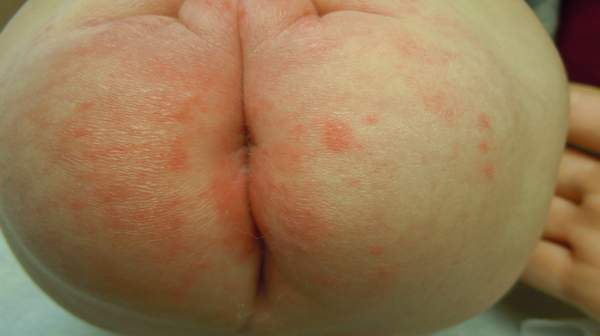What's in this article?
Diaper rash Overview
Diaper rash is a common form of inflamed skin (dermatitis) that appears as a patchwork of bright red skin on your baby’s bottom.
Diaper rash is often related to wet or infrequently changed diapers, skin sensitivity, and chafing. It usually affects babies, though anyone who wears a diaper regularly can develop the condition.
Diaper rash can alarm parents and annoy babies. But it usually clears up with simple at-home treatments, such as air drying, more frequent diaper changes and ointment.
Diaper rash facts
- Diaper rash is very common in babies and is not a sign of parental neglect.
- Diaper rash is most commonly a kind of contact dermatitis.
- Diaper rash may become secondarily infected by bacteria or yeast normally present on the skin. In this case, topical antibiotic ointments provide a rapid and effective therapy.
- Avoidance of skin irritants by frequent diaper changing provides the number-one preventative measure.
- Effective treatments include frequent diaper changes, application of topical barriers (for example, petroleum jelly), and rarely topical antibiotic/anti fungal ointments, or low-potency hydro-cortisone cream. High-potency steroid creams, powders, and concentrated baking-soda/boric-acid baths and neomycin-containing ointments are to be avoided.
What does Diaper rash look like?
If your child’s diaper area looks irritated and red, chances are it’s diaper rash. The skin may also be a little puffy and warm when you touch it. Diaper rash can be mild a few prickly red spots in a small area or extensive, with tender red bumps that spread to your child’s tummy and thighs.
Causes of Diaper rash
Diaper rashes are common in babies between 4 and 15 months old. They may be noticed more when babies begin to eat solid foods.
Diaper rashes caused by infection with a yeast (fungus) called Candida are very common in children. Candida grows best in warm, moist places, such as under a diaper. Candida diaper rash is more likely to occur in babies who:
- Are not kept clean and dry
- Are taking antibiotics or whose mothers are taking antibiotics while breast feeding
- Have more frequent stools
Other causes of diaper rash include:
- Acids in the stool (seen more often when the child has diarrhea)
- Ammonia (a chemical produced when bacteria break down urine)
- Diapers that are too tight or rub the skin
- Reactions to soaps and other products used to clean cloth diapers
Symptoms of Diaper rash
Diaper rash is characterized by the following:
- Skin signs. Diaper rash is marked by red, tender-looking skin in the diaper region buttocks, thighs and genitals.
- Changes in your baby’s disposition. You may notice your baby seems more uncomfortable than usual, especially during diaper changes. A baby with a diaper rash often fusses or cries when the diaper area is washed or touched.
What’s the best way to treat Diaper rash?
Take these steps to heal your child’s skin when you see a diaper rash:
- Keep your child clean and dry by changing his diaper frequently. That may mean getting him up at night for a diaper change
- Rinse his diaper area well at each diaper change. Don’t use wipes that contain alcohol or fragrance. Some parents keep cotton balls and a squirt bottle or an insulated container of warm water at the changing table for easy, gentle clean-ups.
- Pat your child’s skin dry. don’t rub!
- Use an ointment that forms a protective barrier on the skin after every diaper change to help protect your child’s irritated skin from stool and urine. There are several good barrier ointments on the market, including petroleum ointment or petroleum jelly, non-petroleum jelly, lanolin products, and white zinc oxide.
- Put your child’s diaper on loosely or use a diaper that’s a little big on him to allow for better air circulation. If you buy disposables, try a different brand to see if that helps.There are varieties for sensitive skin, for example, and extra-absorbent options will pull more moisture away from your child’s skin.
- When the weather is warm and your child can play outside or in a room with a floor that’s easy to clean, leave his diaper (and ointment) off for as long as possible every day. Exposure to the air will speed healing.
- Consider letting your child sleep with a bare bottom whenever he has a rash. A plastic sheet under the cloth one will help protect the mattress.
Prevent Diaper Rash
- To prevent diaper rash, you should know what causes it. Diaper rash appears most often when babies are not kept clean and dry, have ill-fitting diapers that rub the skin, are sensitive or allergic to the brand of baby wipes you use, start to eat solid foods, or have diarrhea.
- Keep your baby’s bottom clean and dry. Change your baby’s diaper frequently. Washing your baby’s bottom with plain warm water is best a mild fragrance-free soap is only needed if your baby is extra messy. Let the area air dry completely before re-diapering.
- If your baby is prone to rashes, consider using a protective barrier cream, such as zinc oxide or petroleum jelly, before you diaper your baby.
- Be sure your baby is wearing the proper size of diaper as they grow. Too tight and it may irritate the skin; too loose and your baby will have accidents.
- Don’t use plastic diaper covers or diapers with plastic edges. Both help retain moisture and raise the temperature in the diaper area. These are perfect conditions for germ growth.
- Never rub your baby’s bottom with a towel after a bath you might break or irritate your baby’s sensitive skin, which allows bacteria to enter later. Gentle patting is best and don’t forget to cuddle!






